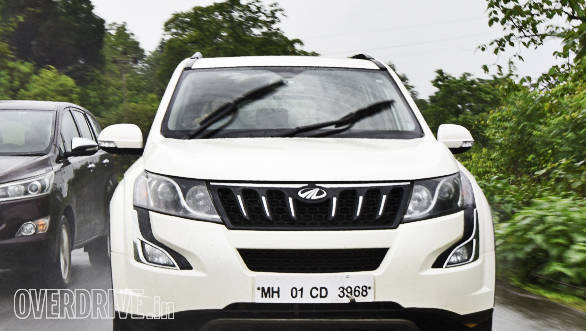Car wipers
The monsoons are finally here. For me it's one of the nicest times to be in a car. Not only because you stay dry, but also because your get to use the wipers. When it drizzles on intermittent setting. When it rains more on normal speed and when it pours on the fast speed.
Wipers have fascinated me for the longest time. My earliest memory that is still so vividly etched in my mind is a journey in really heavy rain from Madras to the temple town of Tirupati. My mother had rented a 1960's Mercedes-Benz W111 that was given out mainly for wedding functions. Along with her brother who lives in Madras, she took me for 'Darshan to Tirupati'. I was just two years old then, and my mom said it was one journey I did in complete silence. I apparently sat quietly besides my uncle, continuously looking out through the windscreen of the Merc. I can believe that because images of the wipers working to clear the rainwater from the windscreen are clearly embedded in my brain. The W111 has oppositely pivoted wiper blades. Yes, unlike modern windscreen wipers that usually move in parallel, the Mercedes-Benzs of the 60s and 70s have wipers that fold over each other and move in opposite directions. This is mechanically more complex but cleans the center of the windscreen very well and also does not leave an un-wiped area in front of the passenger. Interestingly, cars with this sweep pattern proved more cost-effective when exported, as they did not need to be re-positioned for right-hand drive markets.
That journey as a child motoring in the rains sparked of my lifelong affair with car wipers. All through my childhood, whenever I got into a car, I wanted to see how the wipers worked. Later when I ran a workshop, I modified wipers of many Mahindra Jeeps and also those of Premier Padminis. On the Mahindras, I put bigger blades and arms to increase the cleaning area, and in the Fiat I installed aftermarket intermittent speed-setting units. The windscreen washer, which in those days was a manual pump type, was also replaced with an aftermarket electric motor one. The blades, of course, were also replaced with the aftermarket Bosch or Trico ones that were very popular with us enthusiasts.
When the Maruti 800 was launched, my friend, former rallyist Asif Haidery and I fitted the Maruti SS80 with a large single wiper. We also tweaked the electric motor to move faster, and this single wiper mounted below the center of the windscreen attracted a lot of attention and worked well too. Many years later Fiat launched the Uno in India, and it too had a single wiper. The Mercedes-Benz W124 also had a very innovative mono or single wiper. But the one fitted on the Uno was faster, much faster. If I am not mistaken, I recall writing in my review back then, "It's almost like the Uno's single wiper is powered by a V12 engine." The Tata Nano also has a single wiper, but it's mainly for cost reasons. It's also mounted on the right-hand side which means it leaves a large area of the windscreen un-wiped. The Toyota Liva and Etios are also cars with mono wipers.
My fascination with wipers continues. Even now when I evaluate a car, one of the first things I do is turn on the wipers. I recently drove a Maruti Suzuki Vitara Brezza in the rain and found that the wiper blades make an irritating squealing sound, particularly on the downward stroke. I also tried the Hyundai Creta and discovered that its right-hand side wiper almost reaches to the top of the windscreen. As a result, the glass is cleaned almost all the way to the top. Many rivals like the Renault Duster leave at least a few inches un-wiped at the top. This is disturbing for somewhat taller drivers like me. Many cars, including the Toyota Innova, are also guilty of this.

Glass cleaning area and wiper sweep patterns are very important for visibility, especially in a country like ours that gets heavy rains in the monsoon. I remember when I was modifying the wiper system of Mahindra Jeeps in the 80s, I was visited by an official from Mahindra and Mahindra. While he was impressed by the alloy wheels, roll-over bars, nerf bars, extra light brackets etc., he wondered why I was paying so much attention to the wipers. When I told him all the effort was to increase the cleaning area and it's something they as a manufacturer should take up in their development process, he laughed and said, "But that won't help us increase sales."
While we are on the subject of wipers, I will suggest you see a couple of Hindi film songs online as they have fascinating scenes of cars being driven in the rain, with wipers hard at work. The first is Tum Jo Mil Gaye Ho from the film Hanste Zakham. Navin Nischol drives a Premier Padmini with Priya Rajvansh around Bombay at night in the rains, and the filming of the 'wipers at work' is super. Another song where you can see the 'wipers at work' in a Maruti Gypsy is Der Na Ho Jaye from the film Henna starring Rishi Kapoor in the lead. Wipe my wiper wipe, it's a beguiling 'car thing'.
Starts Rs 9.99 Lakhs
1353cc
Automatic
115
242
-NA-
Starts Rs 8.49 Lakhs
1330cc
CVT
106
154
-NA-











